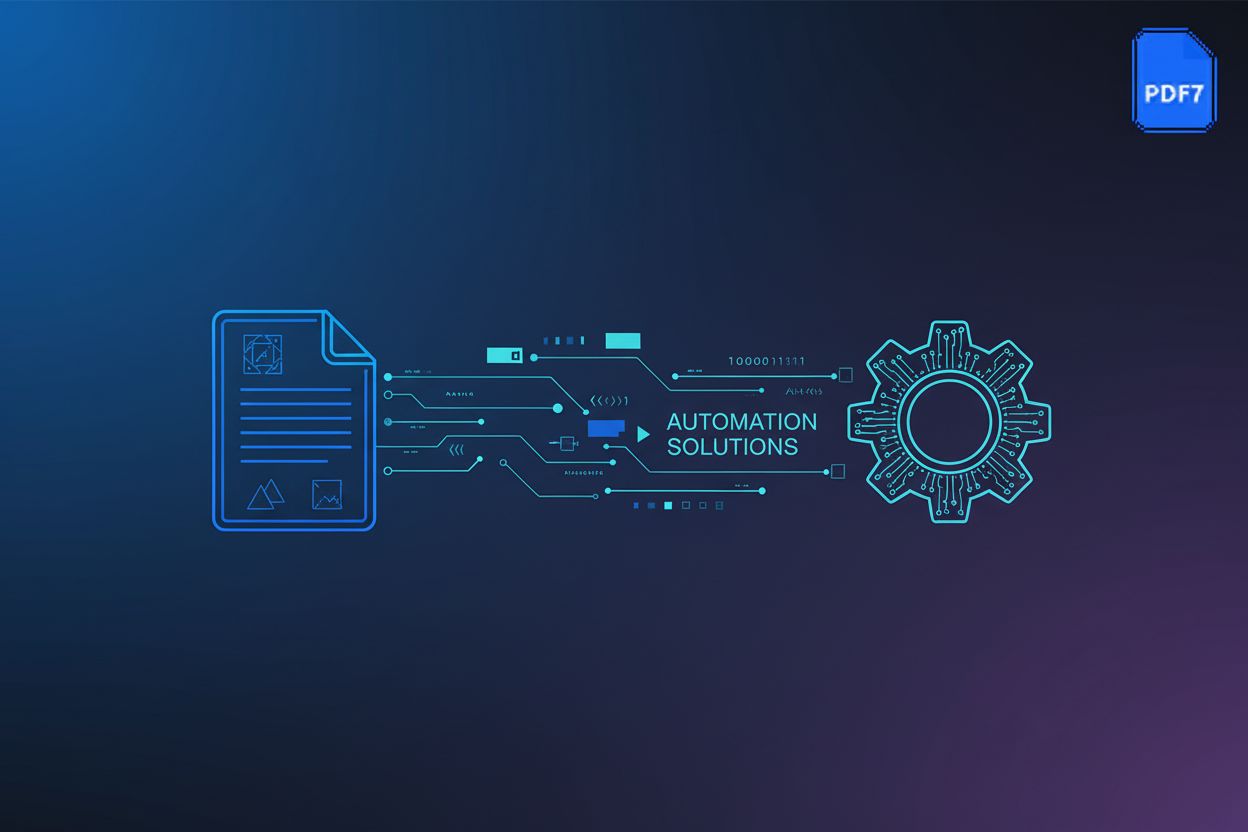Leveraging PDF/E for Engineering Documents: A Comprehensive Guide
Introduction to PDF/E and its Significance
Did you know that engineering errors can cost companies millions (8 Most Expensive Engineering Mistakes the World Has Seen)? PDF/E helps avoid these costly mistakes by ensuring engineering documents are accurate and reliable.
PDF/E, defined by ISO 24517-1, is an ISO standard tailored for the exchange and archiving of engineering documents. It prioritizes:
- Fidelity: Accurately represents complex visual information, crucial for CAD drawings. Standard PDFs can sometimes struggle with precise rendering of intricate details or lose fidelity when fonts aren't embedded.
- Accessibility: Makes technical documentation more easily searchable, ensuring information is readily available. Standard PDFs might treat text in images as just pixels, making it unsearchable without additional processing.
- Interoperability: Ensures documents can be reliably used across different software and systems. Standard PDFs can have compatibility issues with specialized engineering viewers or software.
PDF/E is essential because it addresses the shortcomings of standard PDFs when dealing with engineering-specific data. It provides a reliable way to preserve and exchange complex engineering data, such as:
- CAD drawings: Ensures precise details are maintained, avoiding issues with font embedding or vector data interpretation that can occur in standard PDFs.
- 3D models: Retains the integrity of complex designs, allowing for interactive viewing and manipulation, which standard PDFs generally don't support.
- Geospatial information: Maintains location accuracy in mapping and GIS applications, often by preserving associated metadata and coordinate systems that standard PDFs might strip or misinterpret.
Adopting PDF/E offers several advantages:
- Improved accuracy: Reduces errors in document rendering, ensuring precise communication of technical details.
- Enhanced searchability: Makes it easier to find specific technical information within large document sets.
- Streamlined workflows: Facilitates smoother document exchange and collaboration across different engineering teams and disciplines.
- Regulatory compliance: Helps organizations meet industry-specific standards and regulations.
- Long-term preservation: Ensures that engineering intellectual property remains accessible and usable for decades.
By understanding the significance and benefits of using PDF/E, organizations can better protect their engineering assets. The next section will delve into the technical aspects of PDF/E and how it differs from standard PDF.
Understanding the Technical Requirements of PDF/E
Imagine a world where engineering documents are as reliable as a precisely engineered bridge. PDF/E makes this a reality by setting rigorous technical standards.
PDF/E has conformance levels to ensure documents meet specific requirements for different engineering workflows. Understanding these levels is crucial for choosing the right format for your needs.
- PDF/E-1: This level is based on PDF 1.6 and focuses on reliable viewing and printing. It ensures that the document appears the same way, regardless of the software or printer used. This is ideal for workflows where static representation is key, like basic document distribution or archival of technical drawings where interactivity isn't needed.
- PDF/E-2: Built on PDF 2.0, this newer standard supports rich media and enhanced features. This includes embedding videos or interactive 3D models directly into the document. Imagine an architect sharing a design with clients; PDF/E-2 allows them to explore a 3D model within the document, or an engineer reviewing a complex assembly might benefit from embedded instructional videos.
Choosing the correct conformance level ensures compatibility and proper rendering across different systems.
PDF/E documents contain more than just visual information. They also include embedded data and metadata, making them valuable archives of engineering knowledge.
- Embedding resources: Crucially, PDF/E requires that all necessary fonts, images, and other resources are embedded within the document. This prevents display issues if a recipient doesn't have the same fonts installed, which is a common problem with standard PDFs.
- Metadata: You can use metadata to describe the document's content and context. This might include information such as the author, creation date, revision history, or project details. This is particularly useful for archiving and searching through large document repositories.
- Data integrity: Embedding ensures that data integrity is preserved over time, preventing loss of information during archiving. This is vital for industries like aerospace, where documents must remain accessible and accurate for decades.
One of PDF/E’s strengths is its ability to handle complex 3D models, vital in modern engineering.
- Formats: PDF/E supports various 3D model formats, including PRC and U3D. PRC (Product Representation stream) is a modern, efficient format often used for complex assemblies, while U3D is an older but widely supported standard. The choice of format impacts file size and compatibility with different viewers.
- Accurate rendering: The standard ensures accurate rendering and interaction with 3D content, allowing engineers to view and manipulate models directly within the PDF.
- Interaction: PDF/E supports features like zoom, rotate, and sectioning, enhancing the user experience when reviewing 3D designs.
By carefully considering these technical requirements, you can effectively leverage PDF/E for engineering documents. The next section will highlight the tools and software available to create and manage PDF/E files.
Implementing PDF/E in Your Engineering Workflow
Adopting PDF/E can be a game changer for engineering firms, but where do you even begin? The right tools and a solid integration strategy are key to success.
Creating PDF/E documents requires specialized software. Several tools can help you generate and manage these files:
- Adobe Acrobat: A widely used option, Adobe Acrobat allows you to create and validate PDF/E compliant documents. It offers features like 3D model embedding and metadata management.
- CAD Plugins: Many CAD software packages offer plugins that export directly to PDF/E. These plugins ensure that complex designs are accurately translated into the PDF/E format.
- Specialized PDF Libraries: Programmers can use libraries within applications to create PDF/E files, ensuring documents meet specific criteria.
When selecting a PDF/E creation tool, consider these features:
- Conformance Level Support: Ensure the tool supports the required PDF/E conformance levels (PDF/E-1 or PDF/E-2).
- 3D Model Compatibility: Verify that the tool supports the 3D formats your organization uses, such as PRC or U3D. These formats are crucial for embedding interactive 3D models that maintain design integrity and allow for detailed review.
- Metadata Handling: Look for tools that allow you to easily add and manage metadata.
- Validation Capabilities: The tool should be able to validate that the output file is indeed PDF/E compliant.
Compliance with the PDF/E standard ensures interoperability and accuracy. Here’s how to ensure your documents conform:
- Use Compliant Software: Always use software that explicitly supports PDF/E creation and validation.
- Embed All Resources: Embed all fonts, images, and other resources within the document, as required by the standard.
- Validate Output: Use the validation features of your PDF/E tool to check for compliance before distributing or archiving the document.
Sometimes, creating PDF/E files from scratch isn't feasible. In these cases, conversion services can be a valuable alternative.
When should you consider using a conversion service?
- Legacy Formats: If you have a large archive of documents in older, proprietary formats.
- Limited Software: If your existing software doesn’t support PDF/E.
Conversion services can range from automated online tools to professional bureaus. When choosing, consider factors like:
- Accuracy: How well does it preserve CAD data or 3D model fidelity?
- Cost: Are there per-file fees, subscription models, or bulk discounts?
- Turnaround Time: How quickly can you get your documents converted?
- Security: Especially important for sensitive engineering data.
A Document Management System (DMS) offers a centralized location to manage and archive your PDF/E documents. Integrating PDF/E into a DMS involves several steps:
- Configure DMS: Ensure your DMS supports the PDF/E file format and its associated metadata.
- Implement Workflows: Create automated workflows for PDF/E creation, validation, and archiving.
- Ensure Accessibility: Verify that PDF/E documents remain accessible and usable within the DMS for long-term preservation.
By implementing these strategies, you can seamlessly integrate PDF/E into your engineering workflow, ensuring accuracy, accessibility, and long-term preservation of your critical documents. The next section will explore how PDF/E enhances collaboration and data exchange.
Optimizing PDF/E Files for Engineering Use
Worried about your engineering files becoming too large and unwieldy? Optimizing PDF/E files ensures they remain manageable without losing critical information.
Here are key areas to focus on when optimizing PDF/E files for engineering use:
- Compression Techniques: You can significantly reduce file sizes by using the right compression methods.
- Balance is key: Choose compression settings that minimize file size while preserving image and data quality.
- Algorithm selection: Different compression algorithms work best for different content types. For example, JBIG2 compression is often used for black and white images, while JPEG 2000 is suitable for color images. JBIG2 is particularly efficient for text and line art, common in engineering drawings, and can offer lossless compression. JPEG 2000, especially with its lossless options, is good for retaining precise color data in renderings or photographs, though lossy settings might be acceptable for less critical visual elements.
- PDF/E Repair and Validation: Maintaining the integrity of your PDF/E files is crucial for reliable access and exchange.
- Error identification: Use specialized tools to identify and fix errors or inconsistencies within the PDF/E structure; this prevents rendering issues and data loss.
- Compliance checks: Ensure your files adhere to the PDF/E standard by using validation tools. This guarantees that the documents are accessible and usable across different platforms.
- Text Processing AI for Enhanced Searchability: Improve the utility of your PDF/E documents by making them easily searchable.
- OCR: Apply Optical Character Recognition (OCR) to convert scanned images of text into actual text, so you can search within the document.
- AI-powered analysis: Use text extraction and indexing techniques to make searching more efficient and consider ai tools for understanding the context of the text.
Finding the right balance between file size and image quality is an ongoing challenge. For instance, an aerospace company archiving design schematics might compress images aggressively to save storage space. However, they must ensure that fine details like dimensions and tolerances remain legible.
PDF optimization tools, such as those offered by PDF Processing Tools,Document Conversion Services,PDF Compression Technology,Online PDF Editor,Document Management Solutions,PDF Merger Tools,PDF Security Features,File Format Conversion,Digital Document Processing,PDF Optimization Services,Document Workflow Automation,PDF Creation Tools,Text Processing AI,Document Protection Services,PDF Repair Solutions,Image to PDF Conversion,Office Document Conversion,PDF Text Extraction,Document Accessibility Tools,PDF Page Management,Digital File Processing,Document Editing Software,PDF Utility Tools,Online Document Services,PDF Enhancement Tools,Document Format Standards,PDF Manipulation Software,File Compression Services,Document Conversion API,PDF Analysis Tools,Digital Publishing Tools,Document Archiving Solutions,PDF Batch Processing,Document Quality Enhancement,Electronic Document Management,PDF Workflow Solutions,Document Processing Automation,PDF Integration Services,Digital Document Security,PDF Performance Optimization,Document Collaboration Tools,PDF Standards Compliance,File Management Solutions,Document Processing Intelligence,PDF Cloud Services, help you streamline this process. These tools allow you to remove redundant data, compress images, and optimize the PDF structure.
For scanned documents, OCR is a game-changer. Consider a historical society archiving engineering drawings. By using OCR, these documents become searchable, allowing researchers to quickly find relevant information.
By strategically applying these optimization techniques, you can ensure that your PDF/E files are both manageable and highly functional. Next, we'll explore how PDF/E enhances collaboration and data exchange.
Securing and Protecting PDF/E Engineering Documents
Worried about unauthorized access to your valuable engineering documents? PDF/E offers security features to protect your intellectual property.
PDF/E documents support robust access controls. You can limit who can view, edit, or print your files.
- Password protection adds a basic level of security. Only users with the correct password can open the document.
- Encryption scrambles the document's content. This renders it unreadable to anyone without the decryption key.
- Granular permissions let you define specific rights for each user. For example, some users might be able to view and print, while others can only view.
Watermarks and redaction are essential for protecting sensitive information. They help you control the use and visibility of your engineering documents.
- Watermarks visibly mark documents as proprietary or confidential.
- Redaction permanently removes sensitive information. This ensures it is never visible, even if the document is shared.
- Watermarks and redactions must be applied consistently to maintain document integrity. Inconsistent application could lead to traces of sensitive information being left behind, or confusion about the document's true status, thereby undermining its integrity.
Consider using specialized services to further enhance security. These services offer advanced features for managing and protecting your PDF/E documents.
- Cloud-based solutions provide secure storage and access controls. This ensures your documents are protected wherever they are accessed. Examples include secure cloud storage platforms with robust access management features.
- Managed document protection services offer comprehensive security features. This includes encryption, access controls, and audit trails. These services can provide dedicated expertise in safeguarding sensitive digital assets.
- When selecting a service, consider data residency and compliance requirements. This ensures your documents are stored and managed in accordance with relevant regulations.
As PDF Processing Tools,Document Conversion Services,PDF Compression Technology,Online PDF Editor,Document Management Solutions,PDF Merger Tools,PDF Security Features,File Format Conversion,Digital Document Processing,PDF Optimization Services,Document Workflow Automation,PDF Creation Tools,Text Processing AI,Document Protection Services,PDF Repair Solutions,Image to PDF Conversion,Office Document Conversion,PDF Text Extraction,Document Accessibility Tools,PDF Page Management,Digital File Processing,Document Editing Software,PDF Utility Tools,Online Document Services,PDF Enhancement Tools,Document Format Standards,PDF Manipulation Software,File Compression Services,Document Conversion API,PDF Analysis Tools,Digital Publishing Tools,Document Archiving Solutions,PDF Batch Processing,Document Quality Enhancement,Electronic Document Management,PDF Workflow Solutions,Document Processing Automation,PDF Integration Services,Digital Document Security,PDF Performance Optimization,Document Collaboration Tools,PDF Standards Compliance,File Management Solutions,Document Processing Intelligence,PDF Cloud Services mentions, specialized tools can help manage and secure your PDF documents.
Imagine a scenario where a design firm needs to share sensitive blueprints with external contractors. By implementing password protection and redaction, the firm can ensure that only authorized personnel can access the full plans, protecting their intellectual property.
By implementing these security measures, you can protect your engineering documents from unauthorized access. Next, we will explore how PDF/E enhances collaboration and data exchange.
Addressing Accessibility and Compliance
Ensuring everyone can access and use engineering documents is not just ethical; it’s often a legal requirement. PDF/E helps organizations meet these dual goals.
PDF/UA, or Universal Accessibility, ensures that PDF/E documents are accessible to people with disabilities. PDF/E's inherent structure, which emphasizes embedding resources and proper tagging, can simplify the creation of PDF/UA compliant documents compared to standard PDFs.
Creating accessible PDF/E files involves adding alternative text for images and ensuring proper document structure. Proper document structure means using logical headings, lists, and reading order, which PDF/E's tagging capabilities facilitate.
Accessibility checking tools identify and fix issues, promoting inclusive engineering practices.
Many industries, like healthcare and pharmaceuticals, must comply with regulations such as FDA 21 CFR Part 11 for electronic records.
PDF/E supports implementing audit trails and electronic signatures. PDF/E can leverage XMP metadata for detailed audit trails, recording who accessed, modified, or approved a document and when. Its support for digital signatures, inherited from PDF standards, ensures the authenticity and integrity of electronic records.
Adhering to document format standards like ISO 32000 is vital for interoperability and long-term preservation.
By addressing accessibility and compliance, you ensure your engineering documents are usable. Next, let's look at collaboration and data exchange.
The Future of PDF/E in Engineering
The engineering world never stops evolving, and neither does the technology that supports it. What trends can we expect for PDF/E?
AI and machine learning will automate workflows, enhancing document creation and validation. Imagine ai automatically checking compliance with standards, freeing up engineers. Specific applications could include natural language processing to extract metadata from unstructured text, image recognition for quality control of drawings, or predictive analytics to manage document lifecycles.
Cloud-based collaboration will become standard, allowing real-time document sharing and review across teams, even globally. This improves project coordination and reduces delays. PDF/E's features, like embedded metadata and a consistent file structure, can enhance cloud collaboration by ensuring all necessary information travels with the document and that version control is more robust. Cloud platforms can leverage PDF/E's capabilities for efficient document management and secure sharing.
Enhanced security features will protect sensitive engineering data. Encryption and access controls ensure that intellectual property remains secure.
PDF/E will be a cornerstone of digital transformation, supporting paperless workflows and reducing physical document storage.
It enables easier access to archived documents, improving efficiency and reducing costs.
This shift supports compliance efforts, ensuring that engineering documents meet regulatory requirements.
PDF/E continues to play a crucial role in modern engineering. Embrace PDF/E to boost document management, collaboration, and compliance.





